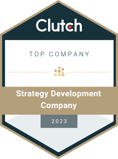
In this episode, we were joined by Micah Lorenc, the Director of Business Architecture for a large insurance organization. For most of his career, Micah has been involved in the corporate world, facilitating and developing strategic plans, as well as in the entrepreneurial world, working on new and interesting creative projects. He recently merged these two worlds through the development of an online course aimed at helping entrepreneurs and small businesses learn about strategic planning.
Micah explained that any business, big or small, will benefit immensely from strategic planning. In contrast, organizations who lack a plan for the future will be making guesses as they move along, rather than strategic decisions that will help them to achieve their goals.
In this episode, Micah shared his process for developing strategy:
- Start with strategic thinking before jumping into the “doing”: Many organizations want to jump right into setting goals and focusing on the “how”. Instead, he advises to pause, take a step back, and focus on where the organization sees itself in a defined period of time (three years, for example).
- Focus on desired outcomes: There’s nothing wrong with identifying objectives as a part of the foundation of strategy development, however, there is a greater shift when if the initial focus is on desired organizational outcomes.
- Develop those outcomes: Once the organization has decided on their desired long-term outcomes, they can then look into what success would look like. Clear, descriptive, targets for success will help to develop the plan.
- Include your people: Once the leadership team has worked to define some key strategic outcomes, it is important to involve the people who will be carrying out the day-to-day implementation to get their input as to how these objectives will be reached. They will be able to identify both what needs to be done, as well as the resources (the PPTI: people, processes, technologies, and information) that may be lacking to complete the tasks.
- Understand and track relevant metrics: Make sure you know what you are measuring and why. The leadership team should take an inventory of what is already being tracked and then map the tracking to the defined outcomes that were set throughout the strategic planning process, rather than tracking everything.
- Buy-in and alignment are important for successful implementation: Especially in larger organizations, employees who are told what to do (especially if objectives have changed) may result in friction. Instead, pilots in a small section of the organization may be helpful for specific struggling departments. This use case can be helpful for starting strategy development with the larger organization at a later date.



